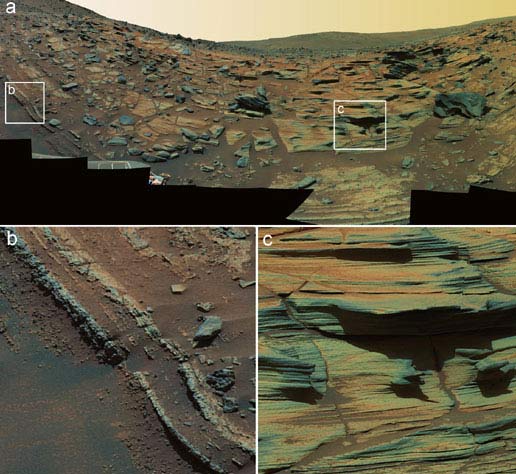Rover Finds Evidence for Volcanic Burst on Mars

NASA'sSpirit rover has stumbled upon evidence of an ancient volcanic explosion at"Home Plate," a plateau of layered bedrock near the rover's landingsite in Gusev Crater.
The findinglends more evidence to the idea that Mars had a watery past, and marks thefirst explosive volcanic deposit seen by Spirit or its rover twin, Opportunity. However, scientists have long known ancient Mars wasvolcanic. The evidence is plain: Olympus Mons, the tallest known volcanoand mountain in our solar system.
Steve Squyres of Cornell University, said the rock'slayers are probably from a volcanic explosion. The findings are detailed inthe May 4 issue of the journal Science.
Evidenceshows the area near Home Plate is mostly basaltic rock--indicating water mayhave mixed with magma beneath the Martian ground. When basalt erupts, Squyres said, it's normally smooth-flowing lava and notblown outward. "One way for basaltic lava to cause an explosion is for itto come into contactwith water--it's the pressure from the steam that causes it to goboom."
The explosivebasalt isn't the only red flag for water. Another example is the high chlorinecontent of the rocks, which might indicate that basalt had come into contactwith brine, or saltwater.
But one ofthe strongest pieces of evidence is a "bombsag" on the lower slopes of the plateau. On Earth, bomb sagsform when rocks eject skyward by a volcanic explosion and fall into softdeposits which deform as they land.
Spirit and Opportunity are in their fourth year of exploringMars. As of April 26, Spirit had spent 1,177 sols, or Martian days, on thesurface of Mars and had driven 4.4 miles, and Opportunityhad spent 1,157 sols and driven 6.5 miles.
Breaking space news, the latest updates on rocket launches, skywatching events and more!
"Consideringtheir age, both rovers are in good health," said John Callas, project managerof the Mars Exploration Rover mission at NASA's Jet Propulsion Laboratory, Pasadena, California.
- All About Mars
- Vote! The Best of the Mars Rovers
- Gallery: Visualizations of Mars
Join our Space Forums to keep talking space on the latest missions, night sky and more! And if you have a news tip, correction or comment, let us know at: community@space.com.
Dave Mosher is currently a public relations executive at AST SpaceMobile, which aims to bring mobile broadband internet access to the half of humanity that currently lacks it. Before joining AST SpaceMobile, he was a senior correspondent at Insider and the online director at Popular Science. He has written for several news outlets in addition to Live Science and Space.com, including: Wired.com, National Geographic News, Scientific American, Simons Foundation and Discover Magazine.
